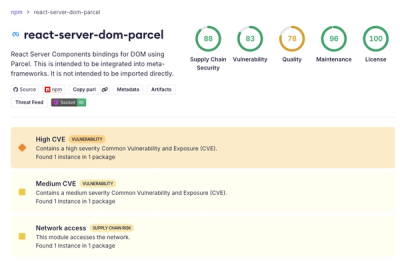
Security News
Deno 2.6 + Socket: Supply Chain Defense In Your CLI
Deno 2.6 introduces deno audit with a new --socket flag that plugs directly into Socket to bring supply chain security checks into the Deno CLI.
Temporary files, directories, and streams for Node.js.
Handles generating a unique file/directory name under the appropriate system temporary directory, changing the file to an appropriate mode, and supports automatic removal (if asked)
temp has a similar API to the fs module.
Supports v0.6.0+.
Please let me know if you have problems running it on a later version of Node.js or have platform-specific problems.
Install it using npm:
$ npm install temp
Or get it directly from: http://github.com/bruce/node-temp
You can create temporary files with open and openSync, temporary
directories with mkdir and mkdirSync, or you can get a unique name
in the system temporary directory with path.
Working copies of the following examples can be found under the
examples directory.
To create a temporary file use open or openSync, passing
them an optional prefix, suffix, or both (see below for details on
affixes). The object passed to the callback (or returned) has
path and fd keys:
{ path: "/path/to/file",
, fd: theFileDescriptor
}
In this example we write to a temporary file and call out to grep and
wc -l to determine the number of time foo occurs in the text. The
temporary file is chmod'd 0600 and cleaned up automatically when the
process at exit (because temp.track() is called):
var temp = require('temp'),
fs = require('fs'),
util = require('util'),
exec = require('child_process').exec;
// Automatically track and cleanup files at exit
temp.track();
// Fake data
var myData = "foo\nbar\nfoo\nbaz";
// Process the data (note: error handling omitted)
temp.open('myprefix', function(err, info) {
fs.write(info.fd, myData);
fs.close(info.fd, function(err) {
exec("grep foo '" + info.path + "' | wc -l", function(err, stdout) {
util.puts(stdout.trim());
});
});
});
As noted in the example above, if you want temp to track the files and directories
it creates and handle removing those files and directories on exit, you must call track().
It's recommended that you do this immediately after requiring the module.
var temp = require("temp");
temp.track();
Why is this necessary? In pre-0.6 versions of temp, tracking was automatic. While this works great for scripts and Grunt tasks, it's not so great for long-running server processes. Since that's arguably what Node.js is for, you have to opt-in to tracking.
But it's easy.
When tracking, you can cleanup() anytime. An object will be returned with cleanup statistics
and the file/directory lists will be reset.
> temp.cleanup();
{ files: { removed: 1, missing: 0 },
dirs: { removed: 0, missing: 0 } }
Note: If you're not tracking, false will be returned.
To create a temporary directory, use mkdir or mkdirSync, passing
it an optional prefix, suffix, or both (see below for details on affixes).
In this example we create a temporary directory, write to a file
within it, call out to an external program to create a PDF, and read
the result. While the external process creates a lot of additional
files, the temporary directory is removed automatically at exit (because
temp.track() is called):
var temp = require('../lib/temp'),
fs = require('fs'),
util = require('util'),
path = require('path'),
exec = require('child_process').exec;
// Automatically track and cleanup files at exit
temp.track();
// For use with ConTeXt, http://wiki.contextgarden.net
var myData = "\\starttext\nHello World\n\\stoptext";
temp.mkdir('pdfcreator', function(err, dirPath) {
var inputPath = path.join(dirPath, 'input.tex')
fs.writeFile(inputPath, myData, function(err) {
if (err) throw err;
process.chdir(dirPath);
exec("texexec '" + inputPath + "'", function(err) {
if (err) throw err;
fs.readFile(path.join(dirPath, 'input.pdf'), function(err, data) {
if (err) throw err;
sys.print(data);
});
});
});
});
To create a temporary WriteStream, use 'createWriteStream', which sits
on top of fs.createWriteStream. The return value is a
fs.WriteStream whose path is registered for removal when
temp.cleanup is called (because temp.track() is called).
var temp = require('temp');
// Automatically track and cleanup files at exit
temp.track();
var stream = temp.createWriteStream();
stream.write("Some data");
// Maybe do some other things
stream.end();
You can provide custom prefixes and suffixes when creating temporary
files and directories. If you provide a string, it is used as the prefix
for the temporary name. If you provide an object with prefix,
suffix and dir keys, they are used for the temporary name.
Here are some examples:
"aprefix": A simple prefix, prepended to the filename; this is
shorthand for:{prefix: "aprefix"}: A simple prefix, prepended to the filename{suffix: ".asuffix"}: A suffix, appended to the filename
(especially useful when the file needs to be named with specific
extension for use with an external program).{prefix: "myprefix", suffix: "mysuffix"}: Customize both affixes{dir: path.join(os.tmpDir()), "myapp"}: default prefix and suffix
within a new temporary directory.null: Use the defaults for files and directories (prefixes "f-"
and "d-", respectively, no suffixes).In this simple example we read a pdf, write it to a temporary file with
a .pdf extension, and close it.
var fs = require('fs'),
temp = require('temp');
fs.readFile('/path/to/source.pdf', function(err, data) {
temp.open({suffix: '.pdf'}, function(err, info) {
if (err) throw err;
fs.write(info.fd, contents);
fs.close(info.fd, function(err) {
if (err) throw err;
// Do something with the file
});
});
});
If you just want a unique name in your temporary directory, use
path:
var fs = require('fs');
var tempName = temp.path({suffix: '.pdf'});
// Do something with tempName
Note: The file isn't created for you, and the mode is not changed -- and it
will not be removed automatically at exit. If you use path, it's
all up to you.
If you want to use the module with Grunt, make sure you
use async() in your Gruntfile:
module.exports = function (grunt) {
var temp = require("temp");
temp.track(); // Cleanup files, please
grunt.registerTast("temptest", "Testing temp", function() {
var done = this.async(); // Don't forget this!
grunt.log.writeln("About to write a file...");
temp.open('tempfile', function(err, info) {
// File writing shenanigans here
grunt.log.writeln("Wrote a file!")
done(); // REALLY don't forget this!
});
});
};
For more information, see the Grunt FAQ.
For now, run test/temp-test.js:
$ node test/temp-test.js
You can find the repository at: http://github.com/bruce/node-temp
Issues/Feature Requests can be submitted at: http://github.com/bruce/node-temp/issues
I'd really like to hear your feedback, and I'd love to receive your pull-requests!
Copyright (c) 2010-2012 Bruce Williams. See LICENSE for details.
The 'tmp' package provides similar functionality for creating temporary files and directories. It also supports automatic cleanup and offers a more modern API with promises and async/await support. Compared to 'temp', 'tmp' is more actively maintained and has a larger user base.
The 'fs-extra' package extends the native 'fs' module with additional methods, including utilities for handling temporary files and directories. While it is not solely focused on temporary file management, it provides a comprehensive set of file system utilities that can be useful in various scenarios.
FAQs
Temporary files and directories
The npm package temp receives a total of 6,585,422 weekly downloads. As such, temp popularity was classified as popular.
We found that temp demonstrated a not healthy version release cadence and project activity because the last version was released a year ago. It has 2 open source maintainers collaborating on the project.
Did you know?

Socket for GitHub automatically highlights issues in each pull request and monitors the health of all your open source dependencies. Discover the contents of your packages and block harmful activity before you install or update your dependencies.

Security News
Deno 2.6 introduces deno audit with a new --socket flag that plugs directly into Socket to bring supply chain security checks into the Deno CLI.

Security News
New DoS and source code exposure bugs in React Server Components and Next.js: what’s affected and how to update safely.

Security News
Socket CEO Feross Aboukhadijeh joins Software Engineering Daily to discuss modern software supply chain attacks and rising AI-driven security risks.